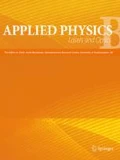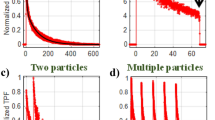Abstract
Trapping of 10-nm-sized single fluorescent bio-molecules in solution has been achieved using high-speed position sensing and electrokinetic feedback forces in the Anti-Brownian ELectrokinetic (ABEL) trap. The high diffusion coefficient of small objects in solution requires very fast, real-time sensing of position, and this has been previously achieved using a simple rotating beam, but improved strategies are needed for the smallest objects, such as single nanometer-sized fluorescent molecules. At the same time, single molecules are limited in photon emission rate and total number of photons, so each emitted photon must be used as efficiently as possible. We describe a new controller design for the ABEL trap which features fast, knight’s tour scanning of an excitation beam on a 2D square lattice and a Kalman filter-based estimator for optimal position sensing. This strategy leads directly to a maximum-likelihood-based method to extract the diffusion coefficient of the object held in the trap. The effectiveness of the algorithms are demonstrated and compared to the simple rotating beam design through Monte Carlo simulations. Our new approach yields tighter trapping and a much improved ability to extract diffusion coefficients.
Similar content being viewed by others
References
H. Cang, C.S. Xu, H. Yang, Chem. Phys. Lett. 457, 285 (2008)
K. McHale, A.J. Berglund, H. Mabuchi, Nano Lett. 7(11), 3535 (2007)
H. Cang, C.S. Xu, D. Montiel, H. Yang, Opt. Lett 32(18), 2729 (2007)
A.E. Cohen, W.E. Moerner, Appl. Phys. Lett. 86, 093109 (2005)
A.E. Cohen, W.E. Moerner, Proc. Natl. Acad. Sci. USA 103(12), 4362 (2006)
A.E. Cohen, W.E. Moerner, Opt. Exp. 16(10), 6941 (2008)
A.E. Cohen, W.E. Moerner, Proc. SPIE 5699, 296 (2005)
Y. Jiang, Q. Wang, A.E. Cohen, N. Douglas, J. Frydman, W.E. Moerner, Proc. SPIE 7038(703807) (2008)
J. Enderlein, Appl. Phys. B 71, 773 (2000)
A.J. Berglund, H. Mabuchi, Appl. Phys. B 78, 653 (2004)
A.J. Berglund, H. Mabuchi, Appl. Phys. B 83(1), 127 (2006)
V. Levi, Q. Ruan, E. Gratton, Biophys. J. 88, 2919 (2005)
S.B. Andersson, Appl. Phys. B 80, 809 (2005)
H. Cang, C.M. Wong, C.S. Xu, A.H. Rizvi, H. Yang, Appl. Phys. Lett. 88, 223901 (2006)
A.J. Berglund, K. McHale, H. Mabuchi, Opt. Exp. 15(12), 7752 (2007)
D. Simon, Optimal State Estimation: Kalman, H Infinity, and Nonlinear Approaches (Wiley, New York, 2006)
D. Magde, W.W. Webb, E.L. Elson, Biopolymers 17(2), 361 (1978)
J. Stockton, M. Armen, H. Mabuchi, J. Opt. Soc. Am. B 19(12), 3019 (2002)
D. Vučinić, T.J. Sejnowski, PLoS ONE 2(8), e699 (2007)
M.T. Tyn, T.W. Gusek, Biotech. Bioeng. 35(4), 327 (1989)
Author information
Authors and Affiliations
Corresponding author
Rights and permissions
About this article
Cite this article
Wang, Q., Moerner, W.E. Optimal strategy for trapping single fluorescent molecules in solution using the ABEL trap. Appl. Phys. B 99, 23–30 (2010). https://doi.org/10.1007/s00340-009-3843-y
Received:
Revised:
Published:
Issue Date:
DOI: https://doi.org/10.1007/s00340-009-3843-y




